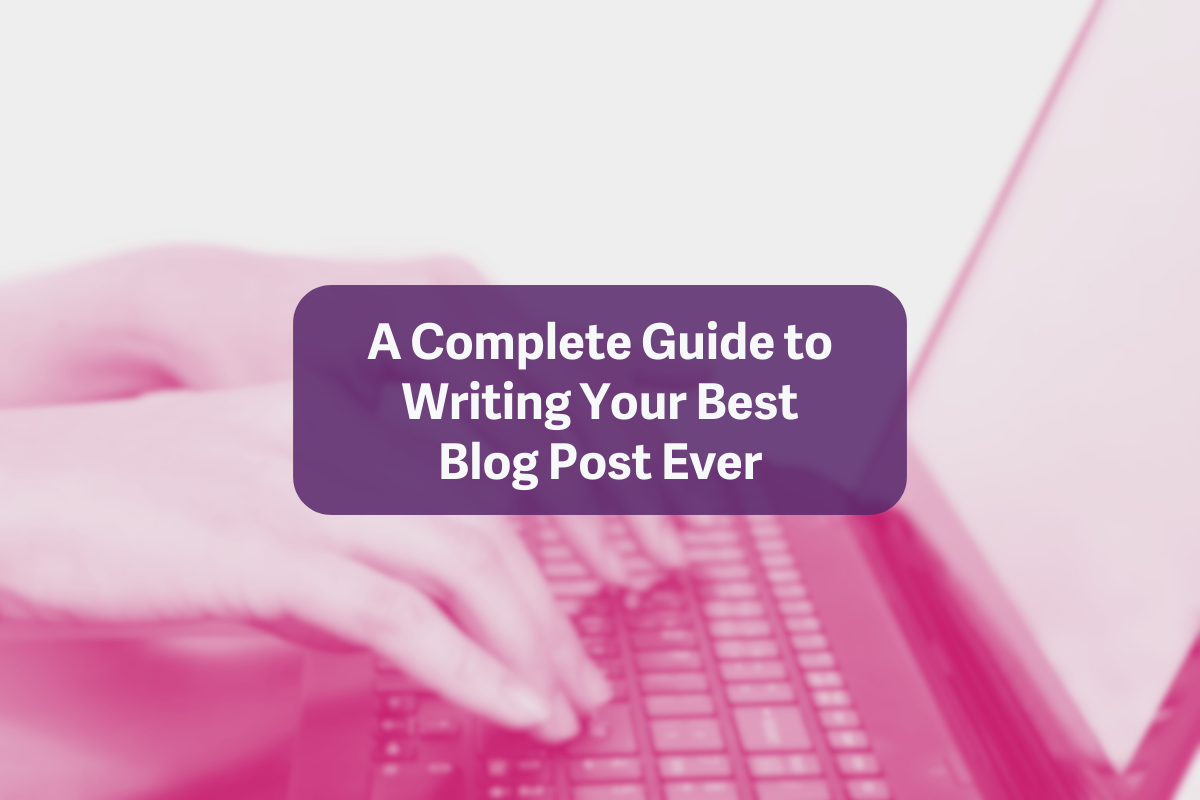A Complete Guide to Writing Your Best Blog Post Ever
Just like the heaviest weight you’ll manage during your workout is always going to be the gym door, the hardest word of a blog to write is always the first one on the page until this guide. Putting pen to paper can cause panic attacks in some, while words seem as though they flow like water for others (or at least that’s what they’d have you believe!).
As copywriters and marketing experts know, however, spinning out a solid blog post is about much more than just putting words down on the page – it involves careful consideration of your audience, your topic, and your purpose. A truly successful blog post should be informative, engaging, and easy to read. You don’t need to be a top-tier writer to draft up a blog, especially when you’ve got the benefit of a few clear and simple tips to help guide you along the way – which is precisely where we come in.
Let’s dig into the details of what turns a good blog into a great blog and together we’ll get those creative juices flowing.
Five Steps Toward Great Blog Writing
1. Choose Your Topic – And Choose It Well
First thing’s first: you’ve got to figure out what you’re writing about! Take some time to brainstorm before putting spilling any digital ink and get all your topic ideas out before choosing the best one for the conversation at hand and going from there.
Not sure where to begin? Here are a few thought-starters that get my brain going when I’m looking to write something up:
- Current events. Take a look at what’s happening in your company or industry for blogging inspo.
- Frequently asked questions. Put out some answers to the common questions your clients ask you – a great blog topic and a great time-saver in future client conversations (assuming they read your blog, of course)!
- How-to guides. Create step-by-step instructions on how to do something related to your niche to both demonstrate knowledge and solve the question of your next blogging topic.
- Interviews. Conduct an interview with an expert or thought leader in your industry and bring that content into your next blog post.
- Resources. Share a list of resources related to your business niche such as favourite podcasts, blogs, books, tools, or websites.
Once you’ve got a list of topics to write on, pick the one you feel most comfortable with and blow it out into a full-fledged post. Set up the structure of your blog post with what you want to include in the beginning, middle, and end; don’t worry about filling in the details just yet, we’ll get to that part soon enough!
2. Open with a Hook
Next, it’s time to move on to the opener of your blog. This is really the most important sentence of the whole blog because if you don’t hook your audience’s attention right off the bat with these critically important words, they’ll just bounce right off your page.
No pressure, right?? 
Don’t worry, though – we’ve got your back with a few tried-and-true methods to ensure your opener pulls your audience in and doesn’t let go:
- Start with a hook. As the title of this sections suggests, lead off with a question, a quote, or an interesting factoid to grab your reader’s attention right away.
- Identify the problem. Clearly state the problem or issue that your blog post will address to let your audience know what they can expect and why they should keep on reading.
- Set the tone. Use active language and an appropriate tone that reflects the mood or emotion of your topic (i.e.: if your post is about a serious issue, be sure to use a sombre tone to match).
- Use descriptive language. Use vivid, descriptive language to really draw your ready in and help them visualize the scene or situation you’re describing.
- Avoid cliches. Whatever you do, stay away from overused phrases or cliches that can make your opener sound generic or unoriginal.
3. Make the Middle Count
Now that you’ve got your audience drawn in and invested, it’s time to focus on the main thrust of your article. The middle bit of a blog is usually the easiest part to write because this is where you’ll share the bulk of your knowledge and content. There’s no big hook or concluding CTA to consider here – this is your chance to simply showcase your wisdom within your area of expertise.
A few considerations to keep in mind while writing out the middle part of your blog include:
- Keeping your language on point. Use language appropriate to your audience’s expectations and reading level – a blog for an engineering company will differ dramatically in its use of language from that of a makeup store’s, for example.
- Breaking the content up. Use subheadings, bullets, lists, indentations, and images to break the content up and make it easier to read. People tend to skim through chunks of text until something catches their attention, so make sure you give them something worth stopping for!
- Keeping it short. Use concise sentences and shorter paragraphs to make your post easy to read and understand. Most people will be interacting with your content on a mobile device as opposed to a large desktop screen, so brevity is key!
- Providing value. This could be through helpful tips, visuals, or industry insights that your audience may not have known or considered properly before.
- Having a clear purpose. Make sure you have a clear purpose or goal for each blog post that keeps your audience in mind the whole time. This will help you stay focused while writing and ensure that your post is valuable and relevant throughout.
4. Conclude Your Thoughts with a Call-to-Action
Once you’ve got through the bulk of your blog, it’s time to close things off – and in the marketing world, that means bringing your article home with an effective call-to-action.
Known more colloquially as a CTA, a call-to-action is an action-oriented instruction that lets your audience know what you’d like them to do next. The best CTAs are short, direct, and compelling, taking the main throughline of your blog article and tying it directly back to a service, product, or activity you’d like your reader to engage with next.
Essentially, the entirety of your blog should ultimately ladder up to your CTA at the end of your piece, making your audience feel as though it’s all been leading up to this point and that of course the next natural step is to follow through on the recommended action. This is the pay-off you get for penning this blog, so make it count with a CTA that’s thoughtful, considered, and sure to do something good for your business.
5. Wrap It All Up
You’ve chosen a topic, your blog’s all written up, and you’re just about ready to post. Good job you! Before you hit that “Publish” button, though, let’s take a second to put the finishing touches on your new masterpiece and wrap everything up nicely with these last few considerations:
- Draft up a catchy title. Your headline is the first thing readers will see, so make sure it’s informative, attention-grabbing, and well-written.
- Give it all a good once-over. Give your post an in-depth edit for grammar, spelling, and punctuation carefully before publishing. A well-written post without errors is more enjoyable to read – and more credible, to boot.
- Share and promote. After publishing your post, share it on social media and other platforms to increase its visibility. Engage with your audience by responding to comments and questions and encourage them to share your post with others if they like what they’ve read to give your content’s viewership a bit of a boost.
And there you have it: your full cover-to-cover guide to help you write the absolute best blog post ever – no matter what your topic, industry, or business might be. Time to get out there, show off those writerly chops, and spark awareness and success to your business all at once. Happy publishing!
Want to learn more about penning blogs that will rocket your business sky-high – or about bringing on the experts to handle all the ins and outs of blogging for you? Contact us at The Marketing Girl to learn more about how we can help ignite your blogging efforts today. Thanks for reading!








